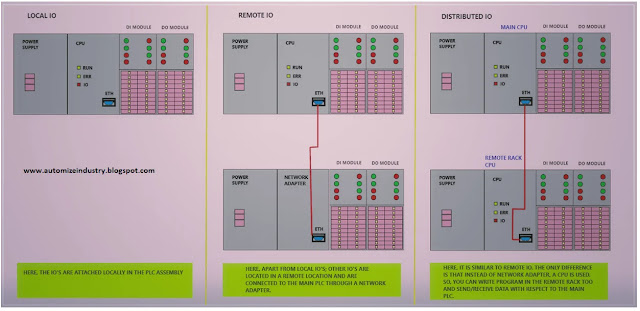Difference Between Local IO, Remote IO and Distributed IO
2 August, 2020.
In this post, we will understand the differences between a local IO, remote IO and distributed IO.
Hello programmers. Inputs and outputs are the heart of a PLC system. These devices only are the ones which make a PLC unique; controlling it through the logic written inside it. Earlier, IO’s were only attached to the PLC assembly; that is, the CPU or by adding expansion modules to the CPU. As time passed and industrial automation revolutionized to a great extent, there were instances where some set of IO’s were located in a very remote location far away from the PLC; and expansion modules were just added and added. This burdened electrical wiring to a great limit and also hardened the overall system design. That demanded a need for some means where you can just connect that IO’s to that particular location and communicate the data to PLC through some remote method. So, remote IO’s and distributed IO’s were evolved.
Different types of IO's in PLC:
So, basically, there are three types of IO’s in a PLC system – local IO, remote IO and distributed IO. Let’s have a look at the image shown above at the start of the topic; and understand the difference.
Local IO in PLC:
Local IO is the basic system that we use. In-built IO’s in the CPU assembly are present and if you fall short of them, then connect expansion modules to the CPU. This is good if your IO’s are limited to a location near the electrical panel and does not exceed a great distance. Of course, if they are outside the range, then too you can connect them to the PLC. But, chances are; signal drop can occur and if more number of far present IO’s are connected, then it can mess up your system wiring.
Remote IO in PLC:
Now comes remote IO to solve the issue. Imagine a scenario where an N number of IO’s are present in cluster in a particular location far away from the main PLC (example – oil refineries and other critical plants). Here, those sets of IO’s are connected to a remote rack. They will communicate with the main PLC through a network adapter. Network adapter is nothing but a communication module that can use any communication protocol available (Ethernet IP, Modbus TCPIP, ProfiBus, ProfiNet etc.). This will reduce the overall wiring stress and also make the system efficient to use. Data will continuously communicate through this adapter to the main CPU in the central panel.
Distributed IO in PLC:
Now, let’s move ahead to a more advanced system – distributed IO. Basically, it is same as remote IO. The only difference as you can see is the CPU present. It is used if you want write logic for that location / section and reduce the programming burden in the centralized PLC. This also properly distributes the overall logic of a very big industrial plant; where IO’s are present in cluster in certain location and far away from the main PLC. You can use remote IO design here and write the program of the whole plant in the central PLC. But, it can strain and increase the overall memory of that PLC and also produce a lengthy program. So, instead, use a CPU on that remote rack, write the program to control that area and communicate the data with the main PLC. Obviously, this remote CPU used will be of a lower version than the central CPU.
So, this is the basic difference between these types of IO’s. There are many remote and distributed modules available with PLC manufacturers and you can use them to increase your level of automation. Standard communication protocols available in industrial automation are used for this purpose. You don’t have to think if you are imagining whether some high-class protocol is used for this motive or not.
I have covered the general theory related to IO’s used in industrial automation. I have also not attempted to cover every type of remote and distributed modules available; you can find it with every PLC manufacturer and it will just differ in it’s design. I have just given you an insight of this type of IO’s used in core industrial sectors. Learn the basics and explore a new type of study in this type of automation.
Thank you guys; I hope you enjoyed reading the practices normally used for this type of study in industrial automation.




Awesome sir informative article thank you and keep it up...
ReplyDeleteThis blog helped, thank you
ReplyDeleteThanks...This will help while designing of system.
ReplyDeleteThanks.
ReplyDeleteHi!
ReplyDeletei was reading your blog first time that was really informative. i was looking that kinda content and finally i got it. thanks for sharing your efforts.
Electrical Automation
Electrical Automation Courses in Pakistan